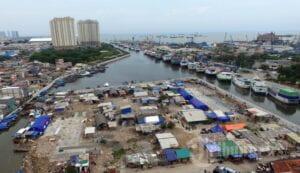This week, I am conducting research for Right to the City on various urban groups in the Global South. Two urban groups come to mind when asked about these urban groups and how they build bridges to demand their right to the city. The first is Kampung Akuarium in Jakarta, and the second is People Affected by Mortgages (PAH) in Madrid.
Kampung Akuarium is a traditional urban village located in the North of Jakarta. The village was demolished in 2016 due to the governor’s intention to construct Great Sea Wall near the area. The residents were required to move into ready-made public housing. They resisted because their economic engine is located near the sea, where the majority of family heads work as fishermen, and because they have a strong attachment to the land on which they reside. The government-prepared public housing is apartment-style, which is not suitable for the villagers who are accustomed to single-family homes. In terms of economics, the public housing is on the outskirts of the city and far from the economic center; therefore, it would be difficult for them to pay the rent, as their primary occupation as fishermen has been eliminated. Not only was Kampung Akuarium targeted for eviction, but so were other areas. A large number of urban villages were evicted in 2016 to make way for the construction of dams and green spaces. Realizing this, Kampung Akuarium formed an alliance with urban villages that have been demolished or are at risk of being demolished. This alliance also was strengthened by the participation of labor organizations and urban environmental activists. As a result of this alliance, during the 2017 election for governor, they made a political pact with then-governor Purnama’s opposition, Anies Baswedan, stating that there will be no more evictions and relocations. In exchange, they commit to mobilizing their votes for Baswedan. Baswedan signed the agreement, and the majority of urban village voters supported him. Even though there were many controversies surrounding the election of Baswedan because Purnama has been accused of blasphemy, this demonstrates the ability of village residents and other groups, such as labor and activists, to mobilize and form an alliance to protect their right to the city.

Kampung Akuariun
Similarly intriguing is the case of PAH. In Spain, practically all underprivileged individuals are affected by the mortgage. When residents fail to repay on their mortgage payments, they lose the asset (the residence) and continue to owe a substantial amount of debt based on the current market value of the property. The evictee owes the difference between the actual purchase price and the value at the time of repossession if the property has depreciated due to market conditions, as was the case during the 2008 housing crisis, which led to mass evictions. This situation prompted a large number of people from diverse backgrounds to join PAH in order to receive assistance regarding this issue. Members of the network include migrant associations, neighborhood groups, squatters, and professionals, among others. To claim their right to the city, they engage in protest and legal action. The organization has become a center for resisting the injustice in the housing crisis, and its members come from diverse backgrounds, but they all share a common goal: a right to just housing in the city.
Besides the from the urban groups I am researching, it is evident that Right to the City is consciously discussing and focusing on the various approaches that urban groups are taking in the United States and internationally in order to find the best way to organize, to build intersectionalities, and most importantly, how these various ways of organizing can assist in the recognition of the right to the city itself. My research will be used for Transformative Organizing, an event that trains and shares best practices on how to organize, mobilize, and ultimately win a policy campaign that guarantees the right to the city for all.


Leave a Reply